The Puppets
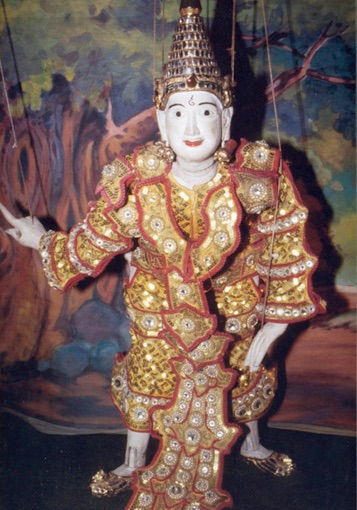
The King of the Celestial Beings (Thagyar Min)
His costume is most opulent, the 7-tiered head dress studded with brilliants, and his robe stiff with sequins and beads. This costume is a replica of the ceremonial dress worn by the Burmese kings on state occasions. This puppet always descends upon the stage from above the handrail, signifying his abode on high. The pointed index finger of his right hand shows that he is in a position to command.
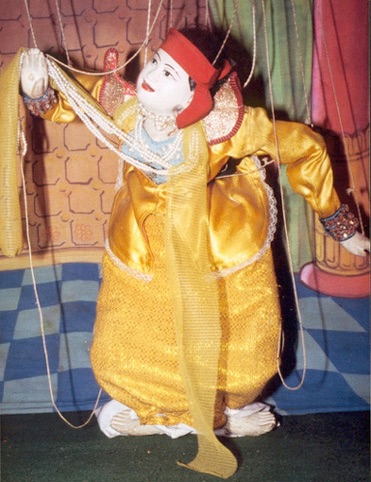
The Medium (Natkadaw)
This puppet is often dressed in red, the favourite colour of Nats; her hair flows down, and a band of red silk circles her brow, two short ends fluttering over the ears. A long silk scarf is tied around her torso, knotted on her bosom. The medium puppet is the first to appear on stage, and her choreography is based on the movements of a real-life medium, the sway and tremble of a 'possessed' person. She lifts the homage-offerings bowl towards heaven, supplicating the Nats, and towards the audience.

The White Horse (Myin)
The White Horse plays an important role in Burmese mythology and the traditional 'Himavunta' (Himalayan) scene in a Burmese puppet show. It is the symbol of the horse-head shaped constellation which was supposed to have appeared at the birth of the universe. The horse dance represents the creation of the earth. The horse puppet is always a white stallion. Tiny silver bells are attached to the halter and trappings which are woven out of bright coloured yarn, gay with pom-poms.
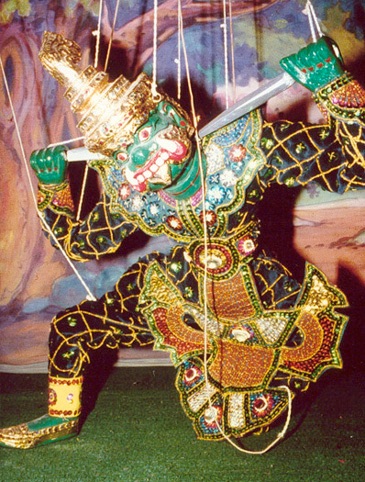
The Ogre (Belu)
Burmese ogres are beautifully costumed creatures. Most carry short swords, one of the five items of the Burmese king's regalia. There are two ogres, the City Ogre (Nan Belu) and the Jungle Ogre (Taw Belu). The city ogre's head dress is topped with a jewelled spike, the jungle ogre's with a plumed crest. Their dance is mostly a show of evil power and strength, and the ominous music, combined with stalking steps, creates a most chilling mood.
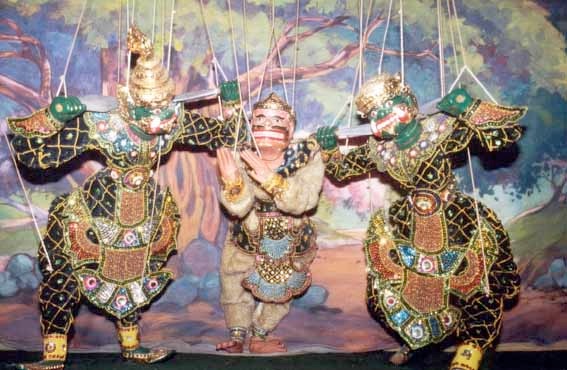
Two Ogres and a Monkey (Myauk)
Before the ogres appear, a monkey romps around the stage. His head is in the stylised form of Hanuman, the monkey-god of the Ramayana epic; he usually wears a few human garments over his furry velvet body. The ogres kick him around a bit and chase him away. After that they chase each other and engage in hand-to-hand combat. The city ogre always wins, and he will exit chasing the jungle ogre.

The Magician (Zawgyi)
This merry magician of the forest is dressed in red, wearing a long and flaring robe trimmed with gold, a red cap on his head, red slippers and trousers under a tucked-up pasoe. With a red staff he grinds medicine, or prods at certain fruits to turn them into nymphs of pleasure. He can fly through air and bore through earth. This puppet has the least number of strings, but his dance steps and acrobatic leaps are fast and complicated. His joints are specially made, to allow for the agility of this character. Any puppeteer who handles this puppet well is regarded as a master of the art.
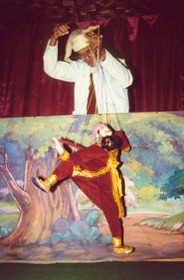
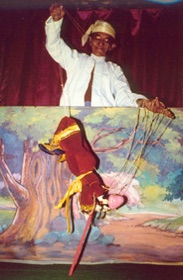
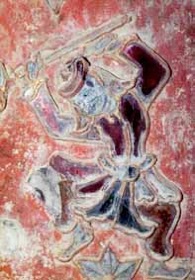
Zawgyi in action. He is also present in places like pagoda's and cloisters, as glass mosaic.
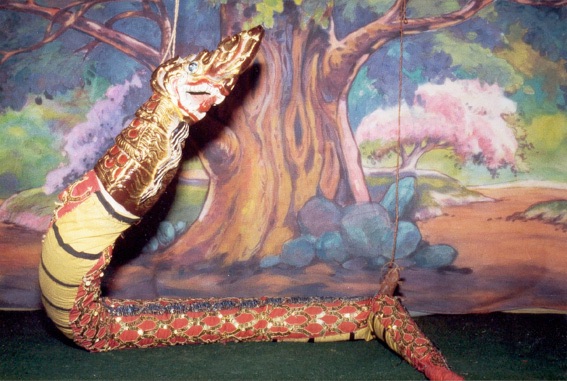
The Mythical Serpent (Naga)
The serpent is the mortal enemy of the mythical bird (Garuda), who chases him around the stage.
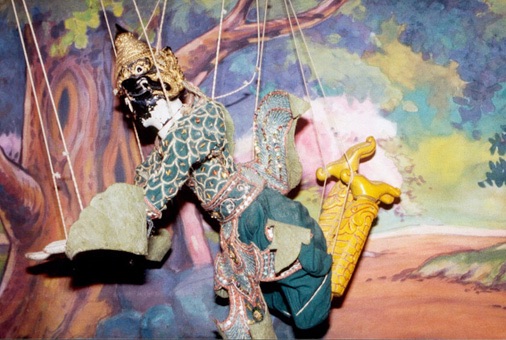
The Mythical Bird (Garuda)
This puppet has a bird's head, human body and hands, with wings attached and talons. He chases the mythical serpent (Naga) around the stage.

The Prince (Mintha)
The Prince is the leading character of most classical plays, together with the Princess. He is gorgeously dressed; he wears a pair of half-length trousers underneath his pasoe, so that he can perform acrobatic feats. Around his head he wears a head wrap (gaung baung). His hair is done in a neat top-knot. In tragic scenes, the hair is let loose, to depict sorrow so deep that the sufferer has no desire to comb his hair.
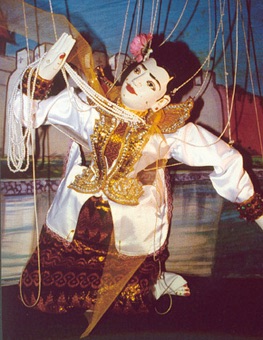
The Princess (Minthamee)
The Princess is the leading character of most classical plays, together with the Prince. She is the romantic heroine. Her hair is done in a top-knot, with a fluffy tress hanging loose on the right side, flowers cascading along its length. The princess embodies the Burmese ideal beauty, so her face is always beautifully sculpted and painted. Her jacket is the most opulent, heavily embroidered, and she wears a lot of jewellery.
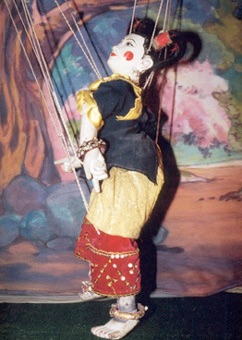
The Page Boy (Thungedaw)
Page boys were young sons of lesser princes and nobles who served as errand boys in the palace. One of their duties was to run ahead of royal processions, to make sure all was in order. The small puppets skip around, fore-fingers outstretched, as they point out things that need to be done. They are dressed rather like jesters, but with gold medallions and chains around their necks. They wear their hair tied in two bunches, one on either side of the head, high above the ears. The design on their cheeks is made with thaneka, cream made of the bark of a tree, to protect the skin from the sun.
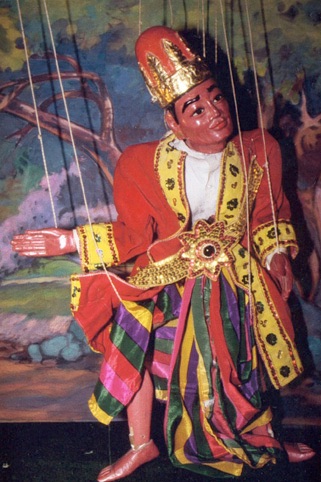
The Home Minister (Wun)
Ministers are primarily used to tell the story and are not dancing puppets. This dignitary is dressed in a long deep red robe, edged with gold, and wears a high velvet red hat, banded with gold and jewels. Under his robe, open at the front, he wears a silk jacket and a pasoe. His walk is known as the 'Minister's dance'; it is a dignified but awkwardly pompous march.

Minister of the Secretariat
This is the Minister of the Secretariat. His robe is similar to that of the Prime Minister, but of a different color. He wears a white tubular circlet on his head, with two narrow rabbit-ears at the back. The ministers are the narrators of the plot, and discuss current affairs as well.

The Royal Astrologer (Ponna)
Brahmins are famed as astrologers, interpreters of dreams, and masters of ceremony for auspicious occasions. In drama, they are the much needed villains. In modern times, the Brahmin is replaced by a comic figure, who is groom to a horse or elephant.
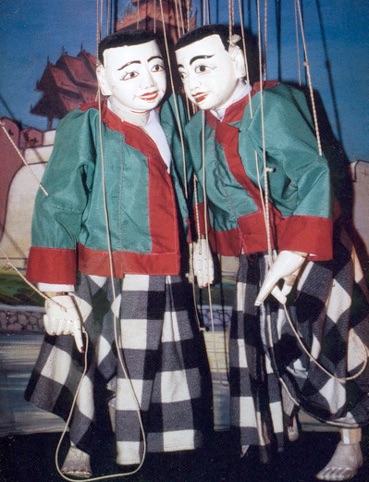
The Jesters (Thancho and Thanpyet)
The two jester puppets are dressed identically in checked pasoes tucked up and short jackets open at the front, with large gold anklets and bracelets. They wear charms around their necks, which are made of sacred threads woven thick, with a silver amulet wrapped across the middle. These are not dancing roles. The jesters have sharp wit and dexterity with puns. They criticise people and comment on actual events.
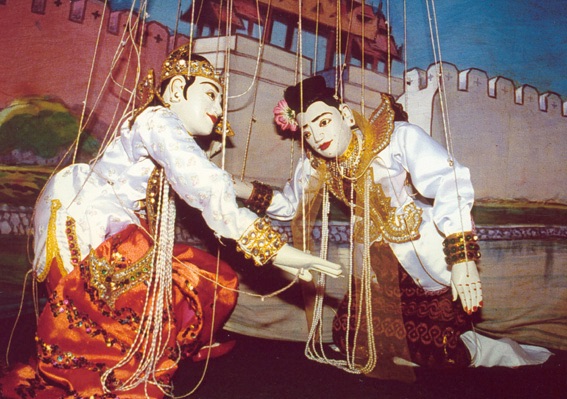
The Prince and the Princess (Mintha and Minthamee)
In every Burmese drama, a compulsory scene is the dance duet. The prince dances beautifully, to impress his love. The duet is the finale of the puppet show, and the favourite item of the public.